late 1941
|
At the time of Pearl Harbor, several thousand Japanese Americans (also known as Americans of Japanese Ancestry or AJAs) served as members of the Hawaiʻi National Guard (298th and 299th Infantry), the United States Army, and the Hawaiʻi Territorial Guard. |
January / February 1942
|
AJAs in the 298th and 299th were temporarily disarmed, but then were returned to their duty stations. The Territorial Guard was temporarily dissolved and disarmed, then reactivated minus the Japanese Americans. A group of these AJAs who were largely students at the University of Hawaiʻi organized themselves as the Varsity Victory Volunteers and offered to help the Army in any civilian capacity. |
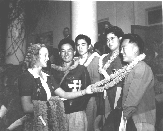 |
27 Feb. 1942
VVV Corps [given a send off]
At the University of Hawaiʻi
Honolulu Advertiser photograph.
HWRD no. 0062. |
12 June 1942
|
AJA men from the 298th and 299th Infantries, engineer battalions, activated reservists, and regular Army were placed into a newly-formed battalion and shipped to the mainland on June 5, 1942. Upon arrival at Oakland, Calif. on June 12, the battalion was redesignated the 100th Infantry Battalion (Separate) and sent to Camp McCoy, Wisconsin, for further training. |
November 1942
|
At Camp McCoy, approximately 70 men were separated from the 100th and, under oath of secrecy, sent to the Military Intelligence Service Language School (MISLS) at Camp Savage, Minnesota. |
1942/43
|
Good record of the 100th at Camp McCoy, Wisconsin, and later at Camp Shelby, Mississippi, led to allowing AJAs to volunteer for military. |
January 1943
|
100th Infantry Battalion sent to Camp Shelby, Mississippi, for large-unit training and maneuvers in Mississippi and Louisiana. |
1 February 1943
|
Army created the 442nd Regimental Combat Team. In response to a call for volunteers, many came forward; some 1300 AJAs from the Mainland and 2500 AJAs from Hawaiʻi–where nearly 10,000 had volunteered–were accepted. |
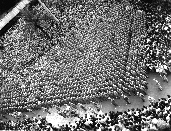
|
28 March 1943
AJA Volunteers in ʻIolani Palace Grounds, Honolulu.
Honolulu Star Bulletin photograph.
HWRD no. 160 |
May 1943
|
The 442nd sent to Camp Shelby to begin their training. For a short time the 100th and the 442nd were stationed together. |
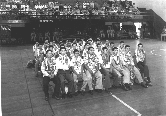
|
9 June 1943
AJA Volunteers as Interpreters, Hilo Armory, Hilo.
Unknown photographer.
HWRD no. 3849 |
August 1943
|
100th Infantry Battalion (Separate) was sent overseas after traveling via railroad from Camp Shelby to New Jersey, and then to New York. They arrived in Oran, Algeria on September 2, 1943 and were attached to the 34th Division, known as the “Red Bull” Division. |
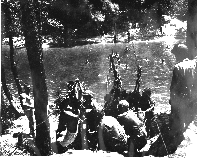 |
19 August 1943
Japanese American soldiers in the Anti-tank Company of the Combat Team ease a gun off
the bank of a stream to ferry it across on steel cables at
Camp Shelby, Mississippi.
Courtesy 442nd RCT Archives. |
22 September 1943
|
100th Infantry Battalion landed at Salerno, Italy, and marched inland (northward). They met fierce opposition at Volturno and at Monte Cassino. |
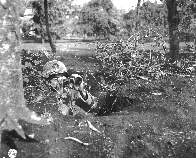 |
12 October 1943
Original U.S. Army Signal Corps Caption: “Italy. Lt. John Ko, of the Japanese American Bn, 133th, on reconnaissance looking for supposed enemy in mock maneuvers preparatory to going into battle against the Germans.”
HWRD no. 1452. Corrected caption: Lt. John Ko, of the 100th Infantry Battalion, 133rd Infantry Regiment on reconnaissance looking for supposed enemy in mock maneuvers preparatory to going into battle against the Germans in Italy. |
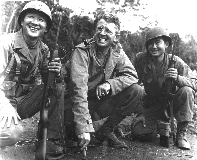 |
1 May 1944
T/Sgt Herbert Miyasaki, Paʻauile [sic], Hawaiʻi (left), and T/Sgt Akiji Yoshimura, Colusa, California, Japanese-American interpreters with Brigadier General Frank Merrill, commander of Infantry troops in Burma, in Noubaum [sic], Burma.
Courtesy 442nd RCT Archives. |
May / June 1944
|
442nd ordered overseas. |
11 June 1944
|
100th Infantry Battalion (Separate) is attached to the 442nd Regimental Combat Team while retaining its unit designation, then redesignated on August 10, 1944 as the 100th Battalion, 442nd Infantry, allowed to retain its numeric designation. The final 442nd RCT consisted of the 100th Battalion, 2nd Battalion, 3rd Battalion, and 522nd Field Artillery Battalion; the 232nd Engineering Company; the 206th Army Band; and Anti-Tank, Cannon, and Service Companies. |
26 June 1944
|
442nd RCT began fighting the enemy at Belvedere, Italy. |
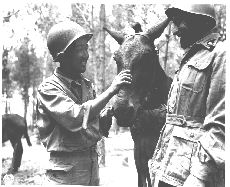 |
12 July 1944
Comrades-in-arms, T/5
William Hirata, Honolulu,
522nd F.A.Bn., 442nd Inf. Reg., 34th Division, and Lorenzo Riba, Italian soldier (right) 11th Pack Mule Co., 34th Div., Fifth Army, Castrellina Sector, Italy.
HWRD no. 1440 |
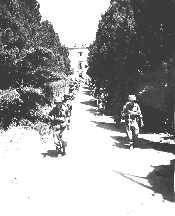 |
15 July 1944
2nd Lt. Masanao Otake (who was commissioned in battle), of Lāhainā, leading his platoon
from the town of Orciano into the advance on Leghorn, with Fifth Army, Italy.
HWRD no. 1435 |
Summer 1944
|
442nd RCT participated in the capture of Livorno, Italy, and pushes the German Army north of the Arno River. |
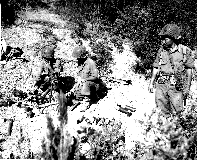 |
7 August 1944
Wallace Higa of Pāʻia, Maui,
James Ishimoto and Jitsuo Kobayashi, both of Honolulu,
in mortar crew of 100th Bn., fire into the hills reported to be active with German snipers, Fifth Army, Montenerro, Italy.
HWRD no. 1448 |
August 1944
|
Anti-Tank Co. of 442nd joined in invasion of southern France, flying in on gliders. |
Autumn 1944
|
442nd RCT sent from Arno River line in Italy to southern France (reconnecting with Anti-Tank Co.) where they traveled up the Rhone River Valley and joined the 36th Division. |
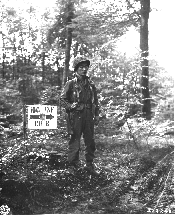 |
12 October 1944. Original U.S. Army Signal Corps caption: “7th Army, Charmois Area, France. Americans of Japanese descent of the 442nd Combat Tea, 100th Inf Bn in bivouac prepare to go into front lines for their first contact with Germans in France. S/Sgt James S Kawashime 2859 Manda Road, Honolulu, Hawaii stands guard.” HWRD no. 1436. Corrected caption: S/Sgt James S. Kawashima of Honolulu stands guard at the 100th Inf. Bn bivouac as the men of the 442nd Combat Team prepare to go into the front lines, Seventh Army, Charmois, France. |
19 October 1944
|
442nd captured the town of Bruyères. |
27 October 1944
|
After a short three-day rest, 442nd ordered to break the German encirclement of the “Lost Battalion.” |
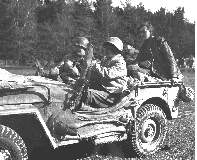 |
Prob. 1944
Two members of the Free French act as guides for the men of the Japanese American Combat Team in France; 2nd Lt. Arthur McColl of Chicago stands in front of a jeep
driven by Pfc. William I. Soma of Kealia.
HWRD no. 1516 |
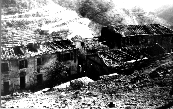 |
Prob 1944
Farmhouse at Sospel, France, photograph attributed to Kay Ihara.
Courtesy 442nd RCT Archive. |
Winter 1944/45
|
522nd Field Artillery detached from main group of 442nd RCT and assigned action in eastern France and southern Germany. |
Nov. 1944-Mar 1945
|
442nd RCT patrolled the French-Italian border. |
Mar 1945
|
442nd returned to Italy in front of the Gothic Line. |
5 April 1945
|
442nd conducted a surprise attack against the flank by climbing an almost vertical mountainside for several hours in the predawn, as well as initiating a simultaneous frontal attack. After attaining the top of the hills they captured two German outposts within slightly more than thirty minutes. The breached a line that had withstood allied attack for six months. The German rout in Northern Italy ensued. |
Late April – May 1945
|
The 522nd Field Artillery participated in the liberation of some sub-camps of Dachau, a short distance northwest of Munich. |
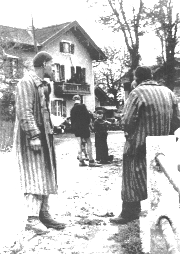 |
Late April 1945
Just released Dachau prisoners in Waakirchen, Germany, photograph by Nobuo Takamori, HQ,
522nd F.A.Battalion.
Courtesy 442nd RCT Archive. |
8 May 1945
|
VE Day: Germany surrendered. |
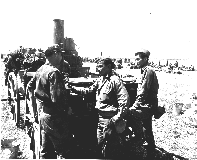 |
18 May 1945
Pfc. Genzo Toguchi and Sgt Seisaburo Taba, both of HQ Co., 100th Bn, 442nd Infantry Regiment, both from Honolulu, inspect a German horse-drawn field kitchen brought to Fifth Army Enemy Concentration Area, Brescia, Italy.
HWRD no. 1445 |
August 1945
|
VJ Day: Japan surrendered, ending official war. |
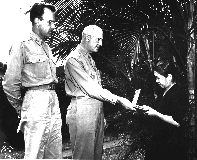 |
27 March 1946. Original U.S. Army Signal Corps Caption: “Mrs. Kuni Sakamoto, 2020 9th Ave., Honolulu T.H., receives the Bronze Star Medal, posthumously awarded to her son, Pvt. Robert I. Sakamoto, for outstanding bravery in battle, from Chaplain H. Olds (Col.), Chaplain, MIDPAC, representing Maj. Gen. George F. Moore, as Chaplain R.G. Pickhardt (Capt.), MIDPAC, looks on.” HWRD no. 1534. Corrected Caption: Mrs. Kuni Sakamoto of Honolulu receives the Bronze Star Medal, posthumously awarded to her son, Pvt. Robert I. Sakamoto of the 100th Bn 442nd RCT, for outstanding bravery in battle from Chaplain H. Olds (Col.), Chaplain, MIDPAC, with Chaplain R.G. Pickhardt (Capt.) looking on. |
 |
9 August 1946
Members of the 442nd Combat Team line the rail of the transport Waterbury Victory as it pulls into port of Honolulu.
HWRD no. 1504 |
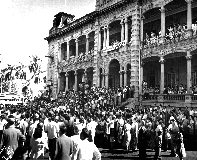 |
9 August 1946
Crowd at ʻIolani Palace Grounds to welcome the men of the 442nd Combat Team.
HWRD no. 1501 |
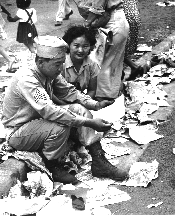 |
Original U.S. Army Signal Corps caption: “15 August 1946 Honolulu, T.H. All over including the shouting, ex soldier Sgt. Shigeh Fukuda of the 442nd Combat Team and his girl Miss Edna Ota stop for a brief look at discharged papers. Sgt. Fukuda is from Kaneohe.” HWRD no. 1488. Corrected caption: 9 August 1946: Sgt. Shigeki Fukuda of the 100th Bn 442nd RCT, from Kāneʻohe, looks at discharge papers with his girl, Miss Edna Ota, at a celebration to honor veterans. |



















